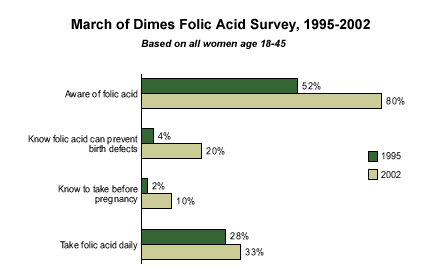Every year, 2,500 babies are born with a neural tube defect (NTD), according to the U.S. Department of Health and Human Services. Among the most common NTDs are spina bifida, a leading cause of childhood paralysis, and anencephaly, the underdevelopment of the brain and skull, which is always fatal. Although no one knows exactly what causes NTDs, scientists say that consuming folic acid, a B vitamin, before and during early pregnancy may prevent them. These birth defects occur in the first few weeks of pregnancy, before most women know they are pregnant. Since 1992, the U.S. Public Health Service (PHS) has recommended that all women of childbearing age consume 400 micrograms of folic acid every day. Almost 70% of women do not.
The ║┌┴¤═° Organization, on behalf of the March of Dimes, has conducted six surveys over the last seven years regarding folic acid consumption*. The latest survey was conducted between Jan. 14 and Feb. 24, 2002. Although some of the results are grim, the trend data do show some improvement.

Multivitamins containing folic acid should be supplemented with foods rich in folic acid, such as orange juice, peanuts, beans, fortified grains and leafy green vegetables. According to the 2002 survey, only 33% of non-pregnant women of between the ages of 18 and 45 take a multivitamin with folic acid every day. This is only a five percentage-point increase, since the survey was first conducted in 1995.
The 2002 study, however, does indicate a huge jump in the number of American women who have heard of folic acid. In 1995, only 52% were "aware of folic acid." That number has risen to 80%. Furthermore, despite the small increase in the number of women taking the vitamin, there is a respectable upsurge in the number who know they should. In 1995, only 2% of women knew they should take folic acid before pregnancy. In 2002, that number was up to 10%. Perhaps even more promising from an awareness standpoint is the significant increase in the number of women who know why they should take folic acid. In 1995, only 4% of women in the target group knew that folic acid helps prevent birth defects. This percentage was up to 20% in 2002.
"We know our campaign is getting results," said Dr. Jennifer L. Howse, president of the March of Dimes, "because a study published in the Journal of the American Medical Association in 2001 showed that NTDs in newborns have decreased 19% from 1995 to 1999. However, many more of these fatal or disabling birth defects could be prevented if more women took a folic acid multivitamin every day."
But if the risks are both great and preventable and awareness is up, why aren't more women actually taking folic acid? According to the March of Dimes report, many women don't think about prenatal care until they are pregnant. What, then, would make them start? "Our survey shows that many women would be willing to change their behavior and take the vitamin if that advice came from a healthcare professional," Dr. Howse said. In fact, a majority would. Fifty-three percent of respondents said they would be "very likely" to take folic acid if a physician or healthcare provider recommended it. Thirty-seven percent would be "somewhat likely."
The March of Dimes is in its fifth year of a national folic acid education campaign. Clearly, the need for the campaign has not ended. "We call on physicians, nurses, midwives, pharmacists, and other health professionals to use every contact they have with women of childbearing age to urge them to take a multivitamin with folic acid daily, " Dr. Howse said.
*The March of Dimes 2002 survey results are based on telephone interviews with a national sample of 2,004 women, aged 18 to 45, conducted from Jan. 14 to Feb. 24, 2002. For results based on samples of this size, one can say with 95% confidence that the error attributable to sampling and other random effects could be ±2.2%.